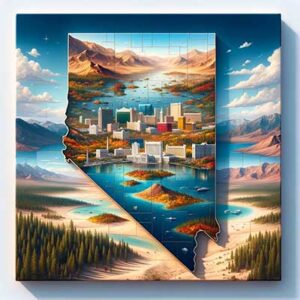Atlanta, Georgia: City and State Statistics You'll Want to Know
Atlanta, the capital of Georgia, is known for our history, wide range of cultures, and strong economy. But beyond the iconic landmarks and cultural significance, there are some fascinating numbers and statistics providing a full picture of what makes Atlanta such an interesting place to live, work, and visit. Whether you’re looking to learn more about its population, economy, or something a bit more unexpected, here’s a deep look into the statistics shaping this dynamic city.

Atlanta at a Glance
Before we get into some of the lesser-known facts, let’s start with some basic information as an overview of Atlanta as a city.
– Population: As of the most recent data, Atlanta has a population of approximately 498,715 residents. While the city itself has just under half a million people, the entire metropolitan area, often referred to as “Metro Atlanta,” is home to more than 6 million people. This makes Atlanta one of the fastest-growing metropolitan areas in the United States.
– Area: The city covers about 136 square miles. Despite being a large metro hub, Atlanta is known for its mix of urban and green spaces, with more than 3,000 acres of parkland.
– Climate: Atlanta enjoys a humid subtropical climate. Summers are hot and humid, with July being the warmest month. Winters are relatively mild, with January being the coldest month, but snow is a rare sight in this Southern city.
– Elevation: One fact surprises many visitors is Atlanta’s elevation. The city sits at an elevation of about 1,050 feet above sea level, making it one of the highest major cities in the southeastern United States. This helps give the city slightly cooler temperatures compared to other parts of the South.
Enjoy all the early historical facts about Atlanta Georgia. Click the button and found out little know facts about this wonderful city, Atlanta Georgia
View all the current trends and historical weather facts about Atlanta, Georgia. You are only on click away from very little know knowledge about Atlanta weather.
Atlanta Facts

NEVADA: Name means “snow capped” in Spanish. Nevada is 110,540 square miles; 485 miles long, 315 miles wide, Nevada ranks as the seventh largest in the United States. Nevada was the 36th state to be admitted. Nevada consists of seventeen counties.
CLARK COUNTY: County was created Feb. 5 1908 and is named in honor of the U. S. senator, William A. Clark from Montana. He is also famous for building the San Pedro, Los Angeles and Salt Lake Railroad. The county is 7,881 square miles, 20,490.6 square kilometers, comparable to the area of Massachusetts.
HENDERSON: The city of Henderson owes its name to Charles Belknap Henderson, a former U.S. senator and a distinguished Nevadan. Henderson’s journey, from being born in California in 1873 to serving in various legal and political roles in Nevada, including a dramatic encounter with a disgruntled client, shaped his remarkable life. His leadership in the Reconstruction Finance Corporation led to the establishment of the Basic Magnesium Plant, around which the townsite, initially known as Basic, developed. In 1944, the townsite was renamed Henderson, commemorating his impactful legacy long after his Senate term ended in 1921.
AREA: (land) 109,826 sq miles (water) 761 sq miles (TOTAL) 110,587 sq miles
CAPITAL: Carson City
FAMOUS DATES: 1861 – Admitted as Territory of Nevada on March 2, 1861.
1864 – Admitted as the State of Nevada on October 31, 1864.
GEOGRAPHIC LOCATION: Latitude 36:10:30 N – Longitude 115:08:11 W
MEAN ELEVATION: (average) 5,489 ft.
HIGHEST POINT: Boundary Peak, 13,140 ft.
LOWEST POINT: is along the Colorado River near its border with California (479 ft.)
COUNTIES: 17
COASTLINE: none
GEOGRAPHIC CENTER: approximately 26 miles to the southeast of Austin, in Lander County
STATE FOSSIL: The Ichthyosaur (Shonisaurus) was designated in 1977 as the state fossil. Nevada has the only complete skeleton. This extinct marine reptile measures 55 feet.
STATE GRASS: Indian Rye Grass (Oryzopsis hymenoides), once a staple food source for Nevada Indians once used this grass as a food source. This grass has ability to re seed itself and is ideal for areas damaged by fire or overgrazing.
STATE REPTILE: The Desert Tortoise (Gopherus agassizi); is the largest reptile in the Southwestern United States. They live in the extreme southern parts of Nevada, spending most of their time underground in burrows to escape the heat. The Desert Tortoise lives to be 70+ years old and ranges in color from black to tan.
STATE ROCK: Sandstone, is found throughout the State. This rock is famous for the natural scenery it provides throughout Nevada.
STATE GEMSTONE: Black Fire Opal, found in only one spot in the North American continent – Virgin Valley, Nevada.
STATE FLAG: After a lengthy design competition, Nevada’s flag was officially adopted on March 26, 1929. It was revised on June 8, 1991, and the state’s name was added. It has a deep blue background and features a yellow, flowing ribbon reading “BATTLE BORN.” This phrase makes reference to Nevada becoming a state during America’s Civil War. A silver star, and the word NEVADA, in a circular pattern, are featured under the ribbon. The silver star represents the states’s rich silver and gold mineral wealth. This is surrounded by green sagebrush with yellow flowers. Note, sagebrush is Nevada’s official state flower.
STATE COLORS: Silver and Blue
STATE SEAL: Adopted February 24, 1866. A gold seal embossed with the words “The Great Seal of the State of Nevada” around the edge. Interior design shows picture of mining, agriculture, industry and Nevada scenery. Under the scroll appears the State motto, “ALL FOR OUR COUNTRY”.
STATE SLOGAN The Battle Born State – Adopted March 26, 1937
STATE MOTTO: All for our country
STATE SONG: “Home Means Nevada” – By Mrs. Bertha Raffetto, Reno
STATE TREE: Single-leaf Pinon, Bristlecone Pine /font>
STATE BIRD: Mountain Bluebird
STATE ANIMAL: Desert Bighorn Sheep
STATE FISH: Lahontan Cutthroat Trout
STATE METAL: Silver
STATE NICKNAMES: The Silver State
STATE FLOWER: Sagebrush – Adopted March 20, 1917
BORDERING STATES: Arizona – California – Idaho – Oregon – Utah
Economy and Employment in Atlanta
Atlanta has long been an economic powerhouse, not just for the state of Georgia but for the entire Southeast. The city’s economy is unique, driven by sectors such as logistics, media, technology, and finance. Here are some key statistics showing how Atlanta stands out in the business world:
– Largest Airport: Atlanta is home to Hartsfield-Jackson Atlanta International Airport, which has held the title of the world’s busiest airport for many years. It handles over 110 million passengers annually. This major hub connects Atlanta to more than 150 domestic and international destinations, making it a key player in global business and travel.
– Fortune 500 Companies: Atlanta boasts the headquarters of 16 Fortune 500 companies, including major names like Coca-Cola, Home Depot, Delta Air Lines, and UPS. It’s one of the top cities in the U.S. for corporate headquarters, reflecting its strong business climate.
– Tech Hub: Atlanta is quickly becoming known as a tech hub in the Southeast, with a growing number of startups and tech companies calling the city home. In recent years, tech jobs in the area have increased by more than 20%. Initiatives such as Tech Square and incubators across the city are helping fuel this innovation boom.
– Film Industry: While many associate filmmaking with Hollywood, Atlanta is often referred to as the “Hollywood of the South.” Georgia has become one of the top states for film production, with Atlanta’s film industry contributing billions of dollars to the local economy each year. Popular TV shows and movies are frequently shot in the city, adding to its cultural influence.
Atlanta's Population and Demographics
Atlanta is one of the most interesting cities in the country, and this diversity has helped shape its unique cultural landscape. The city’s population is a blend of different ethnic backgrounds, contributing to a rich mix of traditions, food, art, and music.
– Racial and Ethnic Makeup: Atlanta’s population is predominantly African American, making up about 51% of the city’s residents. Around 40% of the population is White, with Hispanic, Latino, and Asian communities making up smaller percentages of the city’s demographic mix. This diversity plays a significant role in the city’s cultural scene.
– Age and Gender: The median age in Atlanta is around 33 years, making it a relatively young city compared to many others in the U.S. It’s a city full of young professionals, with a gender ratio fairly balanced, with 51% female and 49% male.
– Education: Education is highly valued in Atlanta, with over 47% of residents holding at least a bachelor’s degree, which is significantly higher than the national average. The city is home to some top universities, including Georgia Tech and Emory University, both of which contribute to the city’s reputation as a center for higher learning.
Transportation and Traffic in Atlanta
Atlanta is a transportation center not just for flights but also for major highways and public transit systems.
– Traffic: One thing Atlanta is known for is its traffic. It consistently ranks among the top cities in the U.S. for traffic congestion. On average, residents spend nearly 60 hours per year stuck in traffic, which is higher than the national average.
– Public Transit: For those looking to avoid driving, Atlanta offers MARTA, the Metropolitan Atlanta Rapid Transit Authority. MARTA provides both bus and rail services, covering much of the metropolitan area. The system carries about 500,000 passengers daily, making it one of the most-used transit systems in the Southeast.
– Cycling and Walking: Atlanta is becoming more bike and pedestrian-friendly, thanks to initiatives like the Atlanta BeltLine, a multi-use trail that circles the city and connects neighborhoods. The BeltLine offers a place for outdoor recreation and a convenient way for people to commute or get around without a car.
Lesser-Known Facts About Atlanta
While much of what you’ve read so far covers the basics, there are also plenty of quirky and lesser-known facts that make Atlanta unique.
– Tree Coverage: Did you know Atlanta is sometimes called “the city in a forest”? That’s because about 48% of the city is covered in trees, which is one of the highest percentages for any major city in the U.S. The abundance of green space is a point of pride for residents.
– World of Coca-Cola: While you might know that Coca-Cola was invented in Atlanta, what’s less known is that more than 1.5 million people visit the World of Coca-Cola museum each year. The museum offers a fascinating look at the history of the iconic brand and even allows guests to sample beverages from around the world.
– Olympics Legacy: In 1996, Atlanta hosted the Summer Olympics, and the legacy of the event is still visible today. Centennial Olympic Park, built for the Games, remains a central gathering place in the city, hosting concerts, festivals, and other major events.
– Ponce City Market: A revitalized historic Sears, Roebuck & Co. building, Ponce City Market is now a major shopping, dining, and office space in Atlanta. It’s one of the largest adaptive reuse projects in the country, combining history with modern-day excitement. The building itself is a mix of retail stores, restaurants, and creative workspaces.
Atlanta by the Numbers
There’s so much to learn about Atlanta, whether it’s the city’s booming economy, diverse population, or unexpected facts like its impressive tree coverage. Whether you’re a resident or a visitor, understanding these statistics helps paint a more complete picture of what makes Atlanta such a dynamic and interesting place to be.

